Denver Zoo name change highlights conservation commitment
The rebranding of Denver Zoo—now officially named Denver Zoo Conservation Alliance (DZCA)—leverages the nonprofit’s longtime commitment to conservation in Colorado and throughout the world, and it positions Denver as a leader in the evolving business of animal care and research. Leading this moment of redefinition is Bert Vescolani, a former high school science teacher and avid SCUBA diver turned CEO. We spoke with Vescolani about DZCA’s rebranding, their ongoing conservation efforts, and the role of modern zoos in environmental stewardship.
How does the name Denver Zoo Conservation Alliance better reflect the work of the Denver Zoo? And why change the name now, after 128 years?
Our new name and logo reflect our purpose to continue delivering exceptional visitor experiences while doubling down on our commitment to conservation. Our conservation work includes research, sustainability practices, wildlife breeding and release, habitat restoration, wildlife rescue and rehabilitation, and so much more. With more than a million species of plants and animals at risk of extinction, our mission, “Inspiring Communities to Save Wildlife for Future Generations,” has never been more urgent.
Tell us about your involvement with the global conservation movement Reverse the Red. How has it informed DZCA’s approach to conservation?
There are more than 45,000 species on the “Red List,” which means they are threatened with extinction. I became very interested in how we move away from the negative, or as I call it, “intriguing catastrophes” to optimism and action. Conservation is a team sport, and there is good work happening around the world. Reverse the Red is an effort that matches our mission, interests and approach.
Can you tell us more about the conservation work DZCA has done?
Our work saving wild species starts right here on our 80-acre campus in Denver. We help preserve healthy genetics in zoo-based wildlife populations through our work with the Association of Zoos and Aquariums (AZA) Species Survival Plan® (SSP) and SAFE Programs. Our Conservation Spotlight Species program connects guests with threatened species and educational programming to inspire conservation action. And we do our part to mitigate the impact of climate change with aggressive sustainability goals aimed at reducing our waste and water and energy consumption.
In the field, we conduct conservation science that is focused on tangible, sustainable solutions for wildlife and ecosystems facing a variety of challenges. Our Field Conservation team applies a holistic approach to wildlife conservation, prioritizing landscapes and species with significant conservation needs, in places where we can make long-term commitments, engage partners and work with local communities to address urgent threats to wildlife. We’re currently active with partners in Colorado, Latin America, Asia and Africa helping to save species from Asian elephants to African lions.
What is the value of zoos today and how are they poised to contribute to conservation efforts?
As people are losing touch with nature and wildlife, and wild places continue to face existential threats, modern accredited zoos are becoming increasingly valuable and important to society. We provide a vital connection between our community and the natural world, while inspiring wildlife-friendly lifestyles and action.
About 2,500 “zoos” are licensed by the USDA to exhibit animals, but fewer than 10 percent of them—only 236 institutions—are accredited by the Association of Zoos and Aquariums. DZCA is both AZA-accredited and certified by American Humane, which promotes the welfare and safety of animals and strengthens the bond between animals and people. This puts us in a relatively small group that has evolved to meet the highest standards.
What’s your must-see habitat at the Zoo?
You get a different experience every day in Toyota Elephant Passage! It’s an incredible home to our Asian elephant bachelor herd and other Asian species, including greater one-horned rhinoceroses and Malayan tapirs. It encompasses more than 10 acres of our 80-acre campus and immerses our guests in the culture of Southeast Asia.




